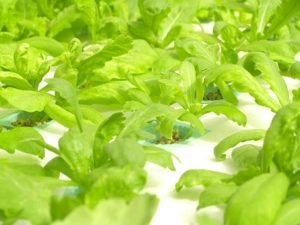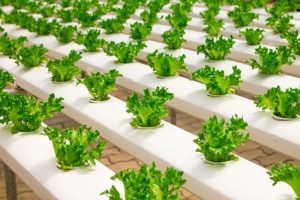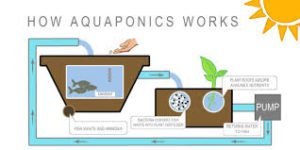Hydroponics vs Aquaponics ; Which is Better?
With the recent global climatic changes, traditional farming methods have proven futile to providing sustainable food supply in the ever increasing population. It’s in this regard that new technologies have been employed in agriculture to give rise to what is popularly known as urban farming.
This post aims to help the reader to understand these two modern farming techniques by analyzing the pros and cons of hydroponics Vs Aquaponics gardening methods.
The Difference Between Hydroponics and Aquaponics
Hydroponics
Hydroponics gardening is a modern method of growing crops purely in a water solution that is filled with the essential nutrients without using soil as a growing medium.

The farmer uses inert media to support the plants and the most commonly grown crops through hydroponics are; vegetables, fruits, flowers, and foliage plants.
The idea behind using growth medium is to eliminate disease causing organism that are found in the soil.
Hydroponics is also economical as it uses less labor since there is no weeding required once the crops are planted.
The idea of hydroponics was discovered long time ago during the Roman Empire although it was never used in large scale until recently where it has gained a lot of popularity as an alternative gardening method.
There are a number of growing mediums used in hydroponics gardening which include; wood fiber, brick shards, clay, vermiculite, and pebbles. Hydroponics gardening can be practiced indoors or outdoors and they are easy to maintain.
Related; Hydroponics Fodder; Advantages & Disadvantages
Advantages of Hydroponics
Hydroponic has widely been used in greenhouse farming to grow tomatoes and vegetables. The below are the proven pros of hydroponics farming technique.
- There is no soil required. Therefore, this practiced can be done even in urban areas with limited space.
- Absence of soil eliminates weeds and any disease-causing organisms that are found in soil farming.
- Less labour requirements since there is no weeding expenses incurred.
- Very economical in terms of water efficiency as it only uses 20% of the water required to carry out a traditional cultivation.
- Pests and disease control is easy since the crops are monitored regularly and grown in a controlled environment.
- 20% Faster than Soil Planting: The integrated low noise pump of hydroponics growing system aerates the water to stimulate plant growth while the upper fan simulates the outside breeze at timed intervals. Grow your plants 20% faster than the traditional soil planting method.
- 4.5L Water Tank and Fan: Hydroponics growing system built-in a fan which spreads pollen in florescence, disperses heat in germination. Indepandent 4.5L water tank can support plants to grow for 1-2 weeks in the growth period. A visual window can see how much water in tank.
- Easy-Setup Germination Kit: 3 steps in all to set up the hydroponic growing system machine. All the factors needed for plant growth – light, simulated soil are included in the hydroponic growing system.
- 2 Growing Modes: 22-Watt LED light of hydroponics growing system turns on/off automatically, simulate the sunlight spectrum, promoting plants’ photosynthesis in any weather. Vegetables Mode emits blue light, red light, far red light and white light; Flower/Fruit Mode emits red light, far red light and white light.
- Growing 12 Plants at Once, Up to 11.02″ in Tall: The height of the lighting part of the hydroponics growing system can be adjusted for plants at different growth stages. Grow 12 plants at a time, works up to 11.02 inches.
Last update on 2022-08-28 at 21:56 / Affiliate links / Images from Amazon Product Advertising API
Disadvantages of hydroponics
Despite this method making it possible to have sustainable food supply throughout the year, it comes with a few cons such as;
- High initial cost is incurred when setting up the system.
- Technical expertise is a-must-have when practicing hydroponics gardening.
- There is a recurrent cost incurred when refilling the depleted nutrients water medium at certain intervals when there is chemical imbalance.

- The system needs to be monitored regularly. Electrical Conductivity (EC) of the solution should be on daily basis to ensure optimum nutrient levels are maintained.
- The system requires energy to run and this can increase production cost as a result of power expenditure. The system requires aeration and pumping of the solution which is mostly done intervals of 4-6 hours.
- Fungal disease risks such as root rot disease also known as Pythium is a real threat to hydroponics gardening. Such diseases can affect the entire crop plantation that is why the systems require close supervision.
- The amount of plants grown in a hydroponics system is less compared to an open field which is not limited to one type of plant.
- The system water needs to be re-emptied at regular intervals due to nutrient imbalances and frequent disposal of such effluent can lead to environmental risks.
Aquaponics
Aquaponics gardening is an integrated system which involves a combination of hydroponics (soilless growing of plants) and rearing of fish (aquaculture) in a natural eco-system. Both fish and plants survive in aquaponics systems through a symbiotic relationship.

The idea behind aquaponics gardening was invented to provide an alternative use of waste that is generated in aquaculture.
As it happens in a natural eco-system, aquaponics rely on nitrogen-fixing bacteria and other worms to breakdown the waste products from the fish into nitrates which are in turn absorbed by the plants.
On the other hand, the plants purify the system water once they absorb the nutrients making it fit for recycling back into the system.
Unlike the traditional method of gardening which requires a lot of water, aquaponics uses only 2% of such water to keep the system running until both fish and plants matures.
Setting up an ideal aquaponics system takes a period of about 1-3 months since you will be required to develop a colony of nitrifying bacteria a process popularly known as cycling.
This process is very essential as the ammonia generated from the fish waste cannot be converted into nitrates until the cycling process is complete.
READ ALSO; 8 Essential Landscaping Maintenance Tips
Since aquaponics garden provides a home for both hydroponics and aquaculture, the system requires high level of attention in order to attain optimal levels.
An ideal aquaponics garden should comprise of 12” deep grow beds all filled with appropriate inert media. The main aim of aquaponics garden is to have a balanced natural state within the entire eco-system.
Therefore, the gardener must ensure that anything that gets into the system is safe and can’t harm the other species.
Here is a video explaining the difference between hydroponics vs aquaponics.
The following are the known pros and cons of this integrated farming system.
Advantages of Aquaponics
- High level of water conservation since the purified water can be recycled back into the system. The main water loss is through transpiration and evaporation which have very minimal impact.
- Minimum waste disposal since the fish wastes are broken down into nitrates by bacteria and worms. The nitrates nutrients are absorbed by the plants and in the process, system water is also purified.

- Risk of diseases exposure is reduced in aquaponics due to the natural eco-system that exists. Fish, plants, and worms all exists to provide a symbiotic relationship.
- Aquaponics systems are easy to maintain since the gardener is not required to check (EC) electrical conductivity in daily basis as it is the case with hydroponics.
- Aquaponics generates high productivity and faster maturity compared to other traditional methods. One can grow a variety of crops in a single system thus, increasing total yields.
- Both fish and crops enjoy organic growth in aquaponics due to the natural eco-system setup unlike hydroponics where plants grow under a sterile man-made environment.
- YEAR ROUND WATER GARDEN: The Back to the Roots Water Garden Duo allows you to grow a succulent or houseplant garden all year round and comes with everything you need to get started – no green thum or big backyard needed.
- CONVENIENT AND EASY: Harvest organic microgreens from your aquarium in just 10 days; Your Water Garden becomes a self-cleaning fish tank that also grows fresh food up top; The fish waste fertilizes the plants on top and the plants clean the water.
- THE PERFECT LIVING HOME DECOR OR GIFT: Each Back to the Roots Water Garden Duo comes with a free STEM curriculum on aquaponic and hydroponic systems to encourage your kids to learn more about it; This award-winning ecoystem is also the perfect gift.
- COMPLETE AQUATIC ECOSYSTEM KIT: This DIY aquaponic fish tank kit is fully equipped with everything you need to get started – radish and wheatgrass seeds, water conditioner, a growing medium for your seeds to take root, water dechlorinator, fish food, and even a fish coupon
Last update on 2022-09-20 at 10:54 / Affiliate links / Images from Amazon Product Advertising API
Disadvantages of Aquaponics
- The Start-up cost is high when installing the system
- There is a higher risk in case of any mechanical failure. While hydroponics has about 5-6 hours of flood-drain cycle, any mechanical damage in aquaponics can lead to serious loss since repair can only be done within 30-45 minutes.
- High energy requirement as the system requires power to keep running the electric circuits and aerators compared to hydroponics.
- The system takes time to mature as the cycling process must be complete for optimum performance. This is not the case with hydroponics as they can easily be set up and utilized immediately.
Wrapping up
Both hydroponics and aquaponics gardening methods have provided an alternative to traditional farming methods by not only becoming cost effective, but also in terms of sustainable food supply throughout the year.
More and more gardeners throughout the world, are adapting to either hydroponics vs aquaponics and they ere now enjoying food supply all year long.
The choice any farmer on whether to practice hydroponics vs aquaponics will be based on the above pros and cons. Each system (hydroponics vs aquaponics) is productive but you should always consider the one which works perfectly for you.


Great content and detailed analysis of Hydroponics Vs Aquaponics. Very informative article especially when urban gardening technology is on the rise globally.
Technology usage in agriculture improves production. Thanks for sharing this useful post.
Great and helpful information. Technology is indeed changing the game of life to the new level.